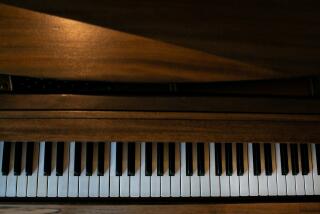Melodious Medicine : Therapists Strike a Chord in Using Music to Treat Bodies and Souls
- Share via
LAGUNA HILLS — Ninety-three-year-old Eugene Clevinger sat in a wheelchair, his weathered face as impassive and blank as the boredom that marks the lives of many elderly retirement home residents.
But when the music started, his fingers began to twitch. Then, his blue eyes warmed in recognition of a familiar ballad.
Before an hour had passed, the former teacher was belting out “America the Beautiful” in a high, squeaky voice and calling for extra hugs from a female guitarist.
Just call it aural medicine.
The music therapy supplied every week at the Marriott’s Villa Valencia retirement home in Laguna Hills might not be in the medical mainstream yet. But with musical therapists pouring out of more than 60 colleges across the country, including Chapman University, the program is firmly established in retirement homes, mental health centers, halfway houses and many other places that treat the body and soul.
“We aren’t going to cure any illness, but music therapy is a wonderful way to help healing and growth,” said Kay Roskam, director of Chapman University’s music therapy program. “And because our research base [into how music affects the brain] has really exploded in recent years, music therapy is steadily achieving legitimacy in the medical community.”
Uses of music therapy are broad. It calms patients with Alzheimer’s disease, helps cancer patients handle their pain and provides a tool of communication for stroke victims.
Because music functions are controlled in a different section of the brain than speech, some stroke patients who might not be able to talk can sing.
“If a patient needs to go to the bathroom or is feeling bad, they can sing out things like ‘I have pain,’ ” even though they can’t otherwise talk, said Karen Skipper, a music therapist of 15 years who works with Villa Valencia residents. “It’s absolutely amazing.”
Skipper said she has seen people whose limbs have been frozen by Parkinson’s disease start to tap their feet involuntarily to the rhythm of a catchy tune.
“If they look down, they actually stop moving,” said Skipper, the activities and therapy director of the Laguna Hills Adult Day Care Health Center. “Rhythm is really a very strong motivator.”
Music touches a variety of chords in people, sparking chemical responses that stimulate memories and emotions, said Chapman’s Roskam.
“The reason music is giving us these feelings literally has to do with chemical reactions in the brain,” she said.
*
At Villa Valencia, many of the residents attending the music therapy session suffer from senile dementia and other age-related afflictions. Most sit in wheelchairs arranged in a loose circle as Skipper walks around showing a sheet of paper bearing the outline of a state.
“OK, who knows what state this is?” she asks, 12-string guitar hanging from a strap around her neck.
Silence.
Then one silver-haired lady wrapped in a lavender knit blanket calls out: “Texas.”
“That’s right, anyone here been to Texas?” questions Skipper, as her left hand wraps around the guitar neck and chords the first note to “Yellow Rose of Texas.”
“A lot of people who gave correct responses are people who are extremely disoriented,” Skipper said after the therapy session. “We exercise their memories.”
“This also does a lot for their self-esteem,” she said. “The elderly experience so many losses--their home, their independence--they often have no place to go and nobody to talk to. [Music therapy] makes them feel like they are real people again.”
Dr. Branko Radisavljevic, an attending psychiatrist for the Los Alamitos Medical Center, has seen dramatic improvements in some of his patients after music therapy.
“I remember one elderly lady who used to be a pianist,” he said. “After her husband got sick, she became terribly disoriented. We had a hard time getting anywhere with her.
“Once she got access to a keyboard, she got into it and that was the turnaround,” Radisavljevic said. “Once you introduce music, it often stirs up an emotional response. I personally feel that music therapy should be utilized, particularly as an addition to other therapies.”
Skipper’s methods are similar to other music therapists who graduate from Chapman University and the other colleges that offer music therapy programs.
Most offer four-year degrees that include standard music theory and practice, as well as specialized training in music therapy. After graduation, they must be certified by the National Assn. of Music Therapy based in Silver Spring, Md.
“I see music therapy as an extension of both performing and teaching,” commented Roskam, who said beginning music therapists often start at about $30,000 per year. “It’s a way to use music in a more challenging way . . . and it’s new enough that we are creating new paths.”
Music is being explored for many uses by researchers.
Roskam will soon be working with theoretical physicist Gordon Shaw, a UC Irvine professor who has been studying how music might help children improve their powers of reasoning.
Shaw and Roskam also will look into how music therapy can affect developmentally disabled children.
“I think we’re just beginning to understand how we think, reason and create,” said Shaw, “and I think music is a window into understanding these brain functions.”
More to Read
Sign up for Essential California
The most important California stories and recommendations in your inbox every morning.
You may occasionally receive promotional content from the Los Angeles Times.













